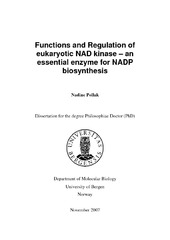Functions and Regulation of eukaryotic NAD kinase - an essential enzyme for NADP biosynthesis
Doctoral thesis
Permanent lenke
https://hdl.handle.net/1956/3161Utgivelsesdato
2008-02-15Metadata
Vis full innførselSamlinger
Sammendrag
NAD and NADP, both major carriers of cellular reducing equivalents, are of vital importance in diverse metabolic and signaling processes. Efficient maintenance and regulation of the reduction-oxidation status is therefore crucial within the cell. The only known pathway of NADP generation is the phosphorylation of NAD catalyzed by NAD kinase (NADK). Owing to the multiple roles of NADP these enzymes have gained considerable interest over the past few years. Genes encoding NADKs have been cloned only recently. The enzymatic activity has been shown to be essential for prokaryotic organisms and important for maintenance of the NADP pool in yeast Saccharomyces cerevisiae and plant Arabidopsis thaliana. While both yeast and plant encode three isoforms, only a single NADK, located in the cytoplasm, has been identified in mammals. Little is known about the function and regulation of NADK in mammalian cells. To investigate the physiological roles of NADK its expression level was altered in human cells. While recombinant NADK was rather specific for the oxidized form, NAD+, as substrate, modulation of cellular NADK activity was reflected in significant changes of the NADPH content. Overexpression of NADK caused a 4-5 fold increase in NADPH but provided only moderate protection towards oxidative stress conditions. Shorthairpin- RNA-mediated downregulation of NADK had surprisingly little impact on cell proliferation, endogenous reactive oxygen species levels and cell viability after oxidant treatment. However, the stable shifts in the NADP redox ratio in the generated cell lines influenced the expression of genes known to be involved in oxidative stress response. Furthermore, phosphorylation of NADK in vitro mediated by calcium/calmodulin-dependent protein kinase II was established. The serine residue 64 was identified as phosphorylation site. The consequence of this modification remains unclear since no influence on the catalytic activity or the subcellular localization of NADK was observed. Two NADK isoforms, which differ only in their N-terminal sequences, were identified in the sea urchin Strongylocentrotus purpuratus. Importantly, for both isoforms a direct activation of NADK by calcium/calmodulin was demonstrated. Although the existence of calmodulindependent NADKs has long been appreciated, the molecular basis of this regulation had so far remained unknown. Moreover, one of the isoforms was also specifically phosphorylated by calcium/calmodulin-dependent protein kinase II. The calmodulin-mediated activation and phosphorylation was associated with the different N-termini, while the catalytic domain is found in the identical C-terminal region of the proteins. The results suggest the N-terminal part of NADKs to be important as a regulatory domain.
Består av
Paper I: Journal of Biological Chemistry 282 (46), Pollak, N.; Niere, M.; Ziegler, M., NAD kinase levels control the NADPH concentration in human cells, pp. 33562-33571. Copyright 2007 by the American Society for Biochemistry and Molecular Biology. Full text not available in BORA. The published version is available at: http://dx.doi.org/10.1074/jbc.M704442200Paper II: Pollak, N.; Berger, F.; Ziegler, M., Calcium/calmodulin-dependent phosphorylation of human NAD kinase. Draft. Full text not available in BORA.
Paper III: Pollak, N.; Niere, M.; Patel, S.; Ziegler, M., Isoform-specific targeting of NAD kinase by calmodulin. Draft. Full text not available in BORA.
